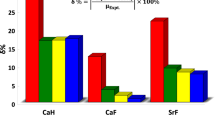Abstract
The adiabatic bound state of an excess electron is calculated for a water cluster (H2O) −8 in the gas phase using the DFT-B3LYP method with the extended 6-311++G(3df,3pd) basis set. For the liquid phase the calculation is performed in the polarizable continuum model (PCM) with regard to the solvent effect (water, ɛ = 78.38) in the supermolecule-continuum approximation. The value calculated by DFT-B3LYP for the vertical binding energy (VBE) of an excess electron in the anionic cluster (VBE(H2O) −8 = 0.59 eV) agrees well with the experimental value of 0.44 eV obtained from photoelectron spectra in the gas phase. The VBE value of the excess electron calculated by PCM-B3LYP for the (H2O) −8 cluster in the liquid phase (VBE = 1.70 eV) corresponds well to the absorption band maximum λmax = 715 nm (VBE = 1.73 eV) in the optical spectrum of the hydrated electron hydr e −hydr . Estimating the adiabatic binding energy (ABE)e t-hydr in the (H2O) −8 cluster (ABE = 1.63 eV), we obtain good agreement with the experimental free energy of electron hydration ΔG 0298 (e −hydr ) = 1.61 eV. The local model (H2O) 2−8 of the hydrated dielectron is considered in the supermolecule-continuum approximation. It is shown that the hydrated electron and dielectron have the same characteristic local structure: -O-H{↑}H-O- and -O-H{↑↓}H-O-respectively.
Similar content being viewed by others
References
E. J. Hart and M. Anbar, The Hydrated Electron, Wiley-Interscience, New York (1970).
L. Turi and P. J. Rossky, Chem. Rev., 112, 5641–5674 (2012).
E. Zurek, P. P. Edwards, and R. Hoffman, Angew. Chem. Int. Ed., 48, 8198–8232 (2009).
I. A. Shkrob, J. Phys. Chem. A, 111, 5223–5231 (2007).
Yu. V. Novakovskaya, Zh. Fiz. Khim., 84, No. 2, 291–306 (2010).
T. Takayanagi, T. Yoshikawa, H. Motegi, and M. Shiga, Chem. Phys. Lett., 482, Nos. 4–6, 195–200 (2009).
I. I. Zakharov, J. Struct. Chem., 55, No. 1, 1–7 (2014).
A. D. Becke, J. Chem. Phys., 98, 5648–5652 (1993).
C. Lee, W. Yang, and R. G. Parr, Phys. Rev. B, 37, 785–797 (1988).
M. J. Frisch, G. W. Trucks, H. B. Schlegel, et al. Gaussian 03, Revision B.02, Gaussian, Inc., Pittsburgh PA (2003).
J. M. Herbert and M. Head-Gordon, Proc. Natl. Acad. Sci. USA, 103, No. 39, 14282–14287 (2006).
A. W. Castleman and K. H. Bowen, J. Phys. Chem., 100, 12911–12944 (1996).
J. V. Coe, Int. Rev. Phys. Chem., 20, No. 1, 33–58 (2001).
B. C. Garrett, D. A. Dixon, D. M. Camaioni, et al., Chem. Rev., 105, 355–389 (2005).
C.-G. Zhan and D. A. Dixon, J. Phys. Chem. B, 107, 4403–4417 (2003).
N. Basco, G. A. Kenney, and D. C. Walker, J. Chem. Soc. D: Chem. Commun., No. 16, 917/918 (1969).
N. Basco, G. A. Kenney, S. K. Vidyarthi, and D. C. Walker, Canad. J. Chem., 50, No. 13, 2059–2070 (1972).
R. N. Barnett, R. Giniger, O. Cheshnovsky, and U. Laudman, J. Phys. Chem. A, 115, No. 25, 7378–7391 (2011).
K. Fueki, J. Chem. Phys., 50, 5381–5385 (1969).
D. F. Feng, K. Fueki, and L. Kevan, J. Chem. Phys., 58, 3281–3294 (1973).
H. P. Kaukonen, R. N. Barnett, and U. Landman, J. Chem. Phys., 97, 1365–1377 (1992).
R. E. Larsen and B. J. Schwartz, J. Phys. Chem. B, 108, No. 31, 11760–11773 (2004).
R. E. Larsen, W. J. Glover, and B. J. Schwartz, Science, 329, 65 (2010).
L. D. Jacobson and J. M. Herbert, Science, 331, 1387-1 (2011).
R. E. Larsen, W. J. Glover, and B. J. Schwartz, Science, 331, 1387–e (2011).
Author information
Authors and Affiliations
Corresponding author
Additional information
Original Russian Text © 2014 I. I. Zakharov.
__________
Translated from Zhurnal Strukturnoi Khimii, Vol. 55, No. 4, pp. 631–640, July–August, 2014.
Rights and permissions
About this article
Cite this article
Zakharov, I.I. Quantum chemical DFT calculations of the local structure of the hydrated electron and dielectron. J Struct Chem 55, 595–604 (2014). https://doi.org/10.1134/S0022476614040027
Received:
Revised:
Published:
Issue Date:
DOI: https://doi.org/10.1134/S0022476614040027




